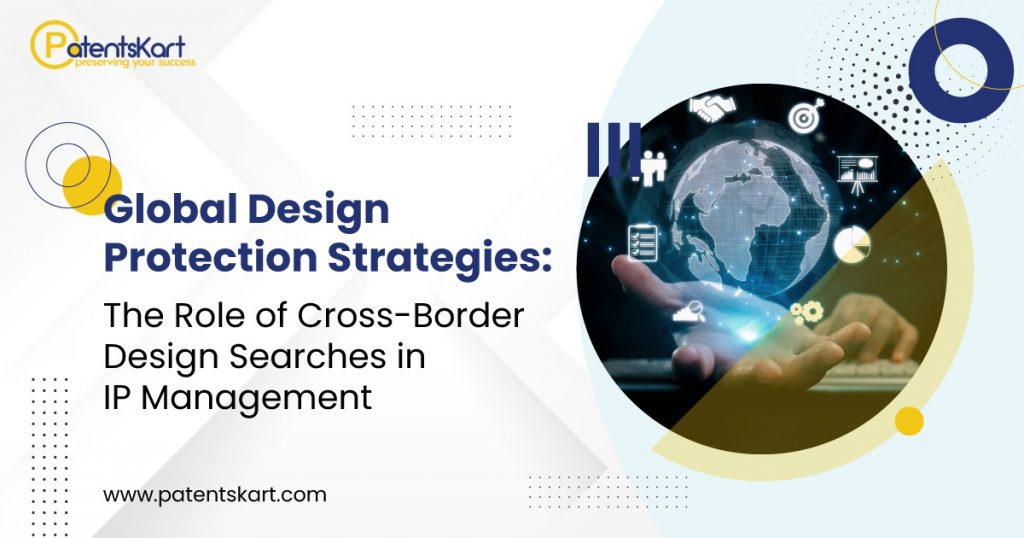In a world where products and innovations can quickly reach a global market, protecting unique designs is a top priority for companies. However, safeguarding these designs is complex, as different countries have diverse intellectual property (IP) regulations. One critical aspect of effective global design protection is the use of cross-border design searches, which enables businesses to assess potential conflicts and minimize infringement risks before entering new markets.
This blog explores global design protection strategies, focusing on the importance and implementation of cross-border design searches in IP management.
Why Global Design Protection Matters
In today’s fast-paced, connected marketplace, a design can be a major differentiator. An innovative product with an aesthetically appealing design can hold strong competitive advantages, build brand identity, and attract customers. However, the risk of unauthorized copying and design infringement is high, particularly as designs become more accessible in international markets.
Effective global design protection strategies help companies:
- Secure their competitive edge: A protected design minimizes the chances of competitors copying or reproducing it in other markets.
- Maintain brand integrity: By preventing unauthorized use, companies can ensure their products are identified with their brand, reinforcing customer loyalty.
- Ensure legal and financial security: Companies can avoid potential litigation by assessing the design landscape of target markets and ensuring compliance with local IP regulations.
Cross-Border Design Searches: A Key Tool in Global IP Strategy
Cross-border design searches are comprehensive analyses of registered designs across multiple jurisdictions to identify prior art, potential design conflicts, and infringement risks. Conducting these searches helps companies make informed decisions about their IP strategies, especially when entering foreign markets.
Benefits of Cross-Border Design Searches
- Early Identification of Conflicts:
By examining registered designs in target countries, companies can determine whether similar designs already exist, preventing costly IP disputes and delays in market entry. - Assessment of Market-Specific Risks:
Each market has unique IP laws, and cross-border searches reveal potential risks that might be more significant in certain regions. For example, the European Union’s Community Design System allows companies to obtain design rights across the EU with a single application, while other jurisdictions, like the United States, have distinct requirements. - Strategic Filing Decisions:
A cross-border design search provides a clear view of existing designs, enabling companies to make informed decisions about where and how to file for design protection, maximizing their resources.
Key Components of a Cross-Border Design Search
Cross-border design searches can be a complex process involving multiple steps and considerations. Here’s a breakdown of essential components:
- Design Databases and Search Tools
Several databases provide access to registered designs globally. The World Intellectual Property Organization (WIPO) provides the Global Design Database, which consolidates data from multiple countries. Additionally, some regions and countries have specialized databases, such as the European Union Intellectual Property Office (EUIPO) for EU designs and the Japan Patent Office for Japanese designs. - Classification and Scope of Designs
Internationally, designs are classified under the Locarno Classification system. This system categorizes designs across various sectors, allowing searchers to pinpoint relevant designs accurately. - Jurisdiction-Specific Searches
Not all jurisdictions have centralized databases, and some designs might be protected under other IP rights (such as copyright or trademarks). It’s essential to conduct jurisdiction-specific searches, especially in high-risk regions like the U.S., EU, China, and Japan, to cover all potential areas of conflict. - Analysis of Prior Art
Prior art analysis involves comparing existing designs to identify similarities and assess potential infringement. IP experts often perform a detailed visual and structural analysis to distinguish key elements of the design in question and any pre-existing designs.
Implementing Cross-Border Design Searches into IP Management Strategy
Incorporating cross-border design searches into your IP management strategy can be streamlined through specific steps:
- Set Geographic Priorities
Begin by identifying high-priority markets for the design. Consider factors like market demand, potential customer base, and the likelihood of IP infringement. Prioritize searches in regions where your product faces the highest risk of replication. - Leverage Technology and Data
Use advanced IP management software and search tools to automate and conduct thorough searches across jurisdictions. These tools help streamline the search process, reduce human error, and provide a more comprehensive overview of potential conflicts. Many IP management platforms offer integrated search functionalities, combining multiple databases and sources into a single interface. - Collaborate with Local IP Experts
Collaborating with IP experts in the target jurisdictions can provide crucial insights into local design laws and cultural nuances. They can help interpret findings from the search and assess the likelihood of IP infringement. - Use Search Results for Strategic Decision-Making
Analyze search findings to make strategic decisions regarding IP filings and design modifications. In cases where potential conflicts are identified, businesses may choose to alter certain design elements to avoid infringement or decide against entering the market altogether.
Global Design Protection Trends and Challenges
The rise of digital products, fast-moving trends, and accessible design tools has led to an increased need for rapid and agile IP strategies. Here are a few trends and challenges shaping the field of global design protection:
- Increased Emphasis on Design Rights in Tech
As consumer electronics and wearables become more design-centric, tech companies are prioritizing design rights alongside patents. Cross-border design searches are essential for navigating this competitive landscape, especially with the growth of similar-looking devices. - Complexity of Regional Laws
While some jurisdictions offer robust design protection mechanisms, others are less developed. This variability makes cross-border searches and compliance with local IP laws complex, requiring expertise and resources. - The Role of AI in IP Management
AI and machine learning are increasingly used to improve the accuracy and efficiency of design searches. Automated visual search algorithms can identify similarities in designs with greater precision, reducing the risk of oversight in the search process.
Conclusion
In a globalized economy, protecting design rights is essential for businesses looking to secure their innovations and expand internationally. Cross-border design searches play a crucial role in these strategies by allowing companies to identify potential conflicts, reduce infringement risks, and make informed IP filing decisions.







